A proven system for General Contractors to win profitable projects through professional relationship-building
The Contractor's Dilemma: Working Harder, Not Smarter

Picture this: It's 9 PM on a Friday night, and you're still at your desk, working on yet another estimate for a prospect who will probably choose the lowest bidder anyway. You've been putting in 80-hour weeks, chasing every lead that comes your way, but your profit margins are razor-thin and your stress levels are through the roof.
If this sounds familiar, you're not alone…90 percent of construction business owners are barely managing to break even, trapped in a relentless cycle of competing on price rather than value.. Meanwhile, the top 5% of contractors are booked solid for 6-12 months in advance, commanding gross profit margins of 20-25% on every project.
What separates these successful contractors from the struggling majority? It's not superior craftsmanship, better equipment, or even lower costs. The difference lies in their approach to sales. They've discovered that the key to sustainable profitability isn't being a better salesperson, it's being a trusted advisor who guides clients through a professional, systematic process.
Why Traditional Sales Approaches Fail in Construction
The construction industry has unique challenges that make traditional sales tactics not only ineffective but counterproductive. Research shows that construction sales cycles are among the longest in any industry, often taking months or even years to complete. During this extended period, multiple stakeholders are involved in decision-making, budgets can change, and competing priorities emerge.
When contractors approach these complex sales situations with pushy tactics or aggressive closing techniques, they create resistance and damage trust. Clients in the construction space are making significant financial investments, often representing their life savings or major business decisions. They need to feel confident in their choice of contractor, not pressured into a quick decision.
"Studies have shown that when a consumer does not proceed, it's most often because the builder failed to ask for the sale. However, research done by Huthwaite proves that asking at least one closing question during your sales conversations raises your success rate by 36%."
The key is finding the balance between being professionally assertive and genuinely helpful. This is where the consultative selling approach becomes invaluable.
The Consultative Selling Revolution

Consultative selling represents a fundamental shift from product-focused selling to client-focused problem-solving. Instead of leading with your services and capabilities, you begin by deeply understanding your prospect's situation, challenges, and desired outcomes.
This approach transforms the traditional contractor-client dynamic in several important ways:
Traditional Approach: "Here's what we do and how much it costs."
Consultative Approach: "Tell me about your vision and the challenges you're facing."
Traditional Approach: Competing on price and trying to be the lowest bidder.
Consultative Approach: Demonstrating unique value and positioning yourself as the obvious choice.
Traditional Approach: Hoping the client will choose you after reviewing multiple bids. Consultative Approach: Building preference and trust before the proposal stage.
When you adopt consultative selling principles, you naturally position yourself as a trusted advisor rather than just another contractor seeking work. This shift in positioning allows you to command premium pricing while building stronger, more profitable client relationships.
The Proven 10-Step Process to Win Profitable Projects
This systematic approach has been tested and refined by thousands of successful contractors. It's designed to be a professional roadmap that builds trust and demonstrates value at every stage, naturally leading to higher-margin projects with better clients.

Step 1: Master the Initial Contact
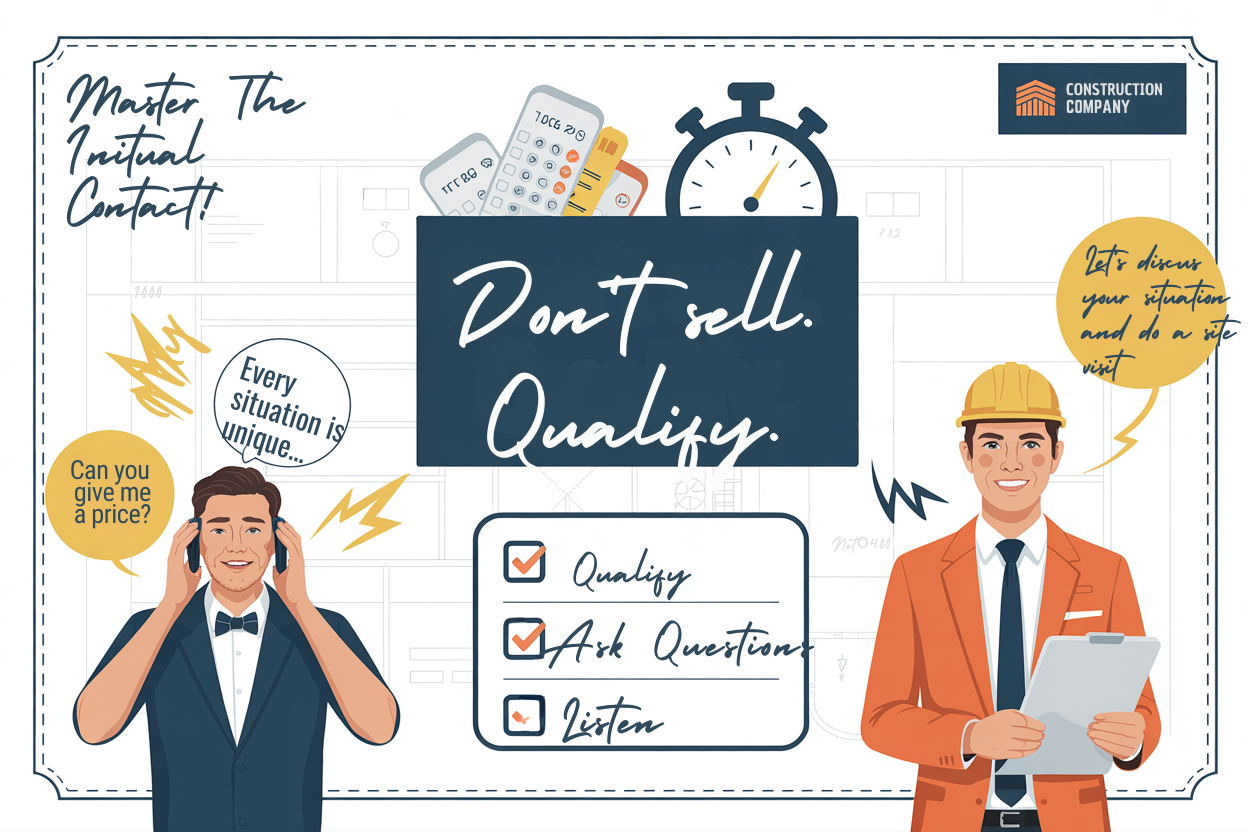
The Challenge: Most contractors jump straight into pricing discussions or immediately offer site visits, which positions them as just another bidder rather than a professional consultant.
The Solution: Use a structured phone script that focuses solely on qualifying the prospect and guiding them to complete a questionnaire. Here's the framework:
"Thanks for getting in touch. I'm [NAME] from [COMPANY]. Before we go any further, I'd love to learn a bit more about your project. Do you mind if I ask you a few quick questions?"
The key is to resist the urge to sell during this initial contact. Your only goal is to determine if this prospect is worth your time and to get them to complete the qualifying questionnaire. This approach immediately differentiates you from contractors who are eager to please and willing to chase any lead.
Step 2: Deploy the Qualifying Questionnaire
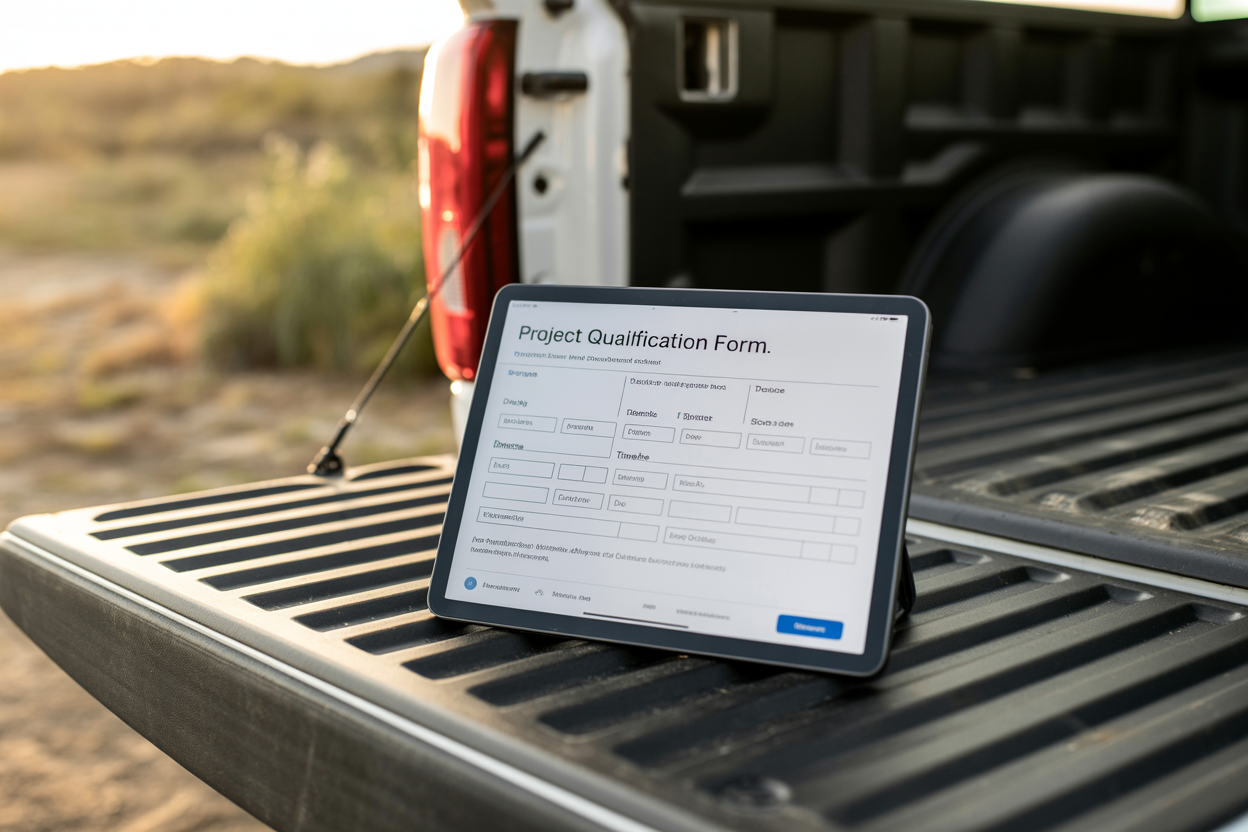
The Reality Check: Your time is worth $150-200+ per hour. Spending 30+ hours pricing jobs for people who can't afford you or aren't ready to build is a costly mistake that keeps you trapped in the 95% of struggling contractors.
The Strategic Filter: A professional questionnaire uncovers critical information before you invest significant time:
- Budget range and funding status: Are they financially qualified?
- Timeline and urgency: When do they realistically want to start?
- Decision-making process: Who needs to approve the project?
- Project scope and requirements: What exactly do they want to accomplish?
- Previous building experience: Are they realistic about the process?
This questionnaire serves as your first filter, allowing you to segment prospects into categories: ready now with budget, ready but budget too low, future prospects to nurture, or those just exploring options.
Step 3: Create Your "WOW" Info Pack
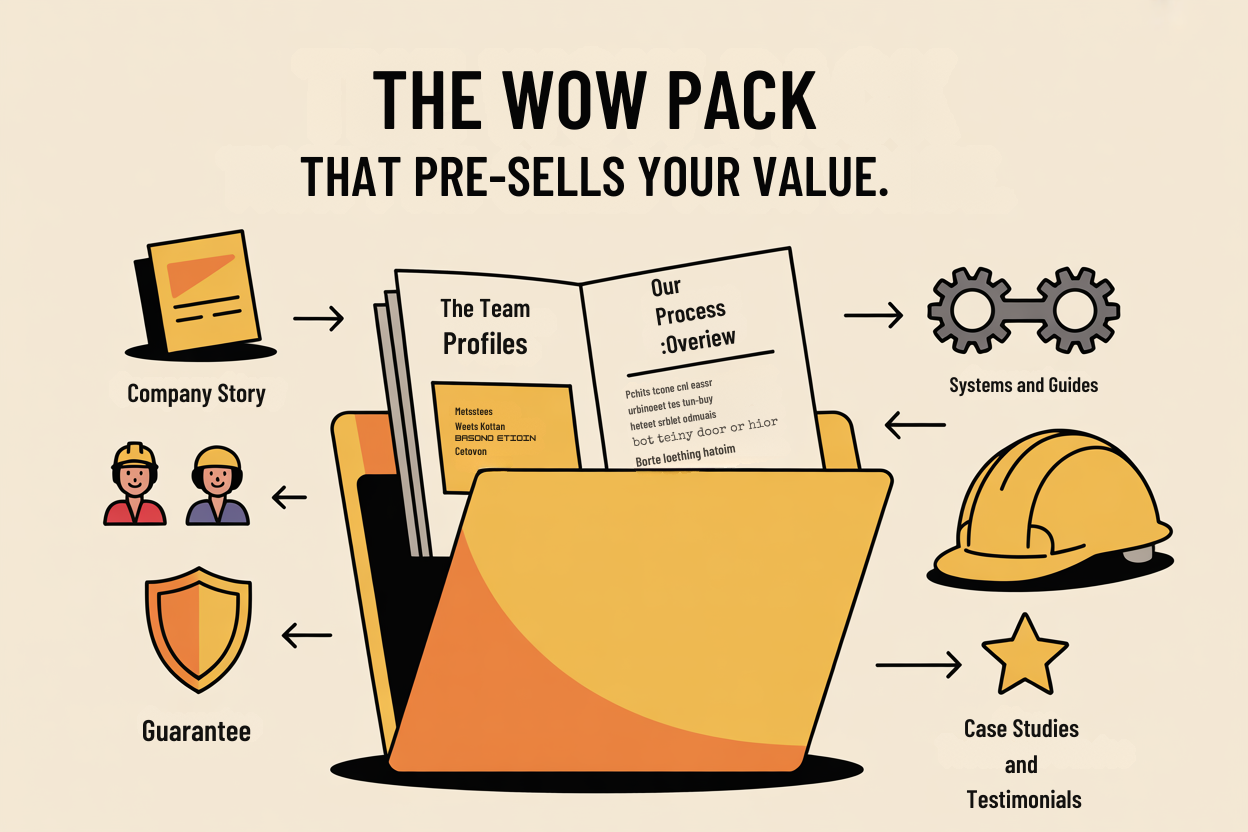
The Competitive Advantage: While your competitors are competing on price, you're competing on professionalism and perceived value. A well-crafted information pack can pre-sell your services and position you as the premium choice before you even meet.
Essential Components:
- Company story and values: Why you're in business and what drives you
- Team profiles: Who they'll be working with and their expertise
- Process overview: How you manage projects from start to finish
- Quality guarantee: What you promise and how you protect their investment
- Case studies and testimonials: Proof of your capabilities and client satisfaction
When prospects receive this professional package, they're already 70% sold on your value before the first meeting. This dramatically reduces price sensitivity and positions you as the obvious choice.
Step 4: Conduct the Warmup/Triage Call

The Checkpoint: This call prevents you from wasting time on site visits that go nowhere. Too many contractors skip this step and discover during the site visit that one spouse isn't on board, the budget isn't real, or the timeline is unrealistic.
The Process: Review their questionnaire responses, confirm all decision-makers will attend the site visit, and pre-frame the investment range. This conversation should feel consultative, not pushy:
"Based on what you've shared, similar projects typically range from [X] to [Y]. Is that aligned with your thinking?"
If they express concerns about your process or try to skip steps, respond professionally:
"I understand you're keen to move forward. We've found this process ensures the best outcome for our clients. Would you like me to explain why each step is important?"
Step 5: Execute the Professional Site Visit
The Differentiation Opportunity: This isn't just another contractor walking around with a tape measure. This is your chance to demonstrate why you're different from the "cowboys" in your market.
The Team Approach: Bring key team members including your project manager, estimator, and relevant specialists. This shows depth and professionalism while gathering comprehensive project information.
The Consultation Mindset: You're not there to sell, you're there to assess if this project is right for your company. Ask quality questions:
- "What's the most important thing you want to achieve with this project?"
- "What concerns you most about the building process?"
- "What would make this project a complete success for you?"
Step 6: Facilitate the Strategy Session
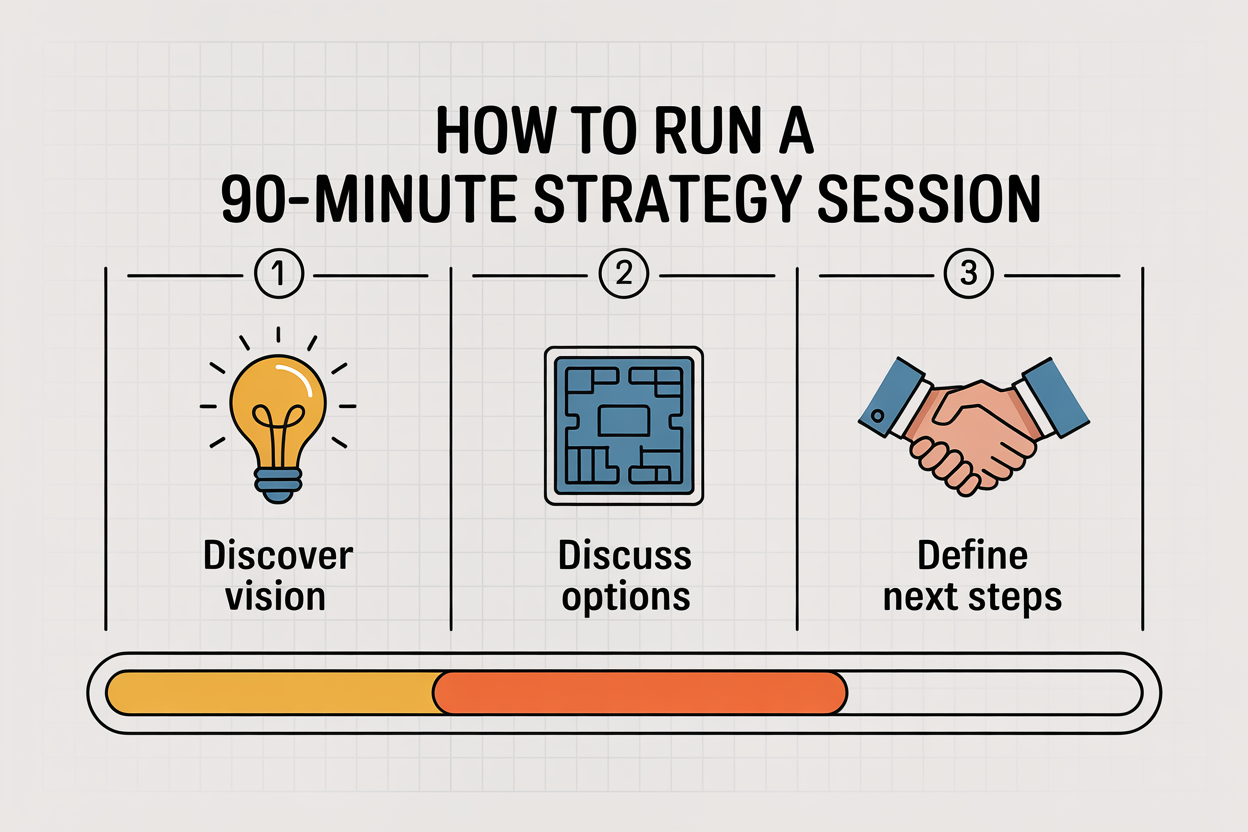
The Game Changer: This is where you separate yourself from every other contractor. Instead of rushing to quote, you sit down with the clients to deeply understand their vision, concerns, and non-negotiables.
The Setting: Your office or a professional meeting room, 60-90 minutes dedicated time, all decision-makers present, no interruptions.
The Conversation Flow:
- Opening: "Today's about getting crystal clear on your vision and ensuring we can deliver exactly what you want, within budget and timeline."
- Middle: Deep dive into their 'why,' explore options and possibilities, share relevant experience, address concerns proactively
- Close: Clear next steps, timeline for proposal, set expectations
This collaborative approach transforms you from "just another builder" to a trusted advisor and project partner.
Step 7: Present Your Proposal Professionally
Beyond the Numbers: Your proposal should be a comprehensive document that clearly articulates the value you bring, not just the cost of the project. Include detailed scope of work, your project management process, quality standards, and timeline.
The Presentation: Don't just email the proposal. Schedule a dedicated meeting to walk through it, answer questions, and reinforce the value of your services. This is your opportunity to address any concerns and confirm the partnership.
Step 8: Maintain Professional Momentum
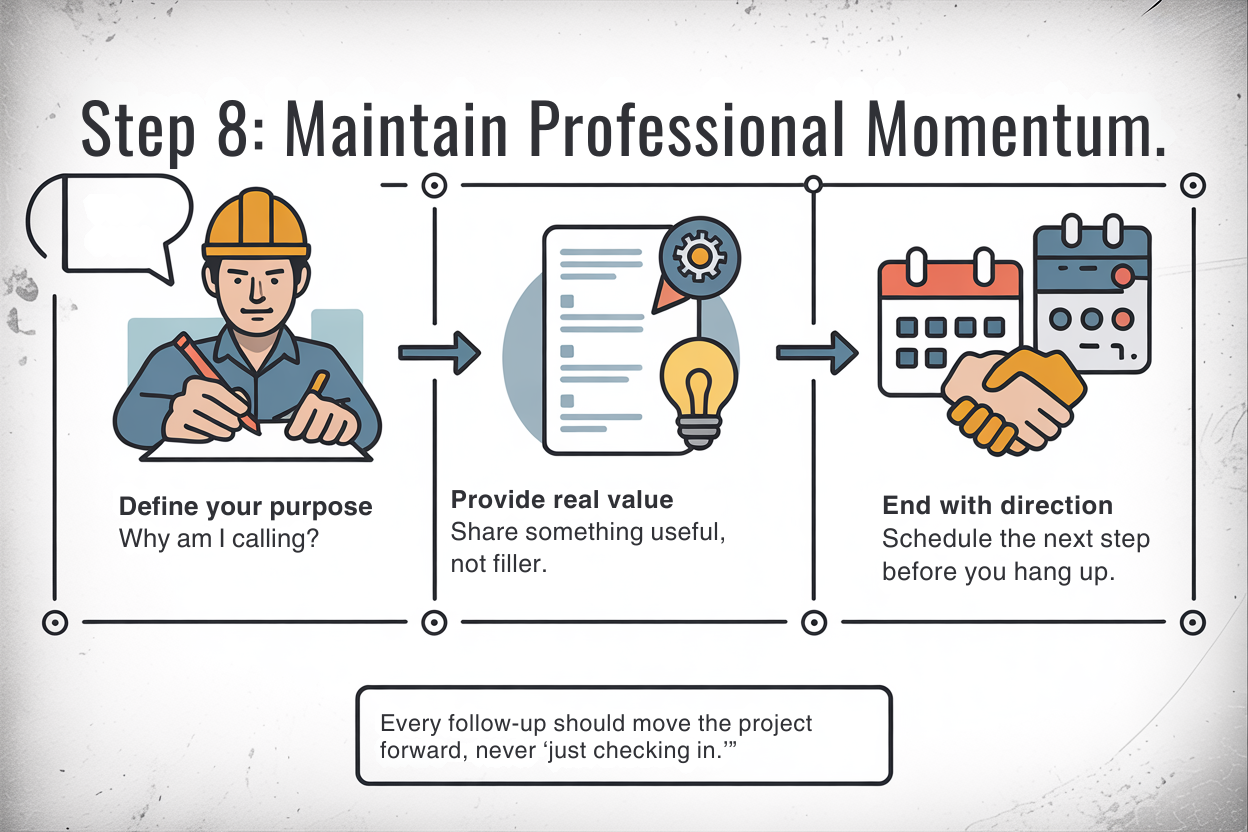
The Follow-Up System: Consistent, purposeful follow-up keeps you in control of the sales process. Never make a "just checking in" call. Every communication should provide value and have a clear next step.
The Framework: Always ask yourself three questions before contacting a prospect:
- Why am I calling?
- How am I going to provide value on this call?
- What action do I want the prospect to take?
Schedule the next meeting before ending the current conversation, and always follow up with an email outlining what was discussed and the agreed-upon next steps.
Step 9: Close with Confidence
The Natural Conclusion: If you've followed the process correctly, closing should feel natural rather than pushy. The contract should be clear, comprehensive, and protect both parties.
Making It Easy: Provide multiple ways for clients to review and sign contracts. Remove friction from the process while maintaining professionalism.
Step 10: Nurture Long-Term Relationships
The Multiplier Effect: Your relationship with the client doesn't end at project completion. A satisfied client becomes your most powerful marketing asset, potentially generating multiple referrals over time.
The Process: Conduct a post-project review, gather feedback and testimonials, and maintain periodic contact. These clients often become repeat customers and your best source of high-quality referrals.
Common Objections and How to Handle Them
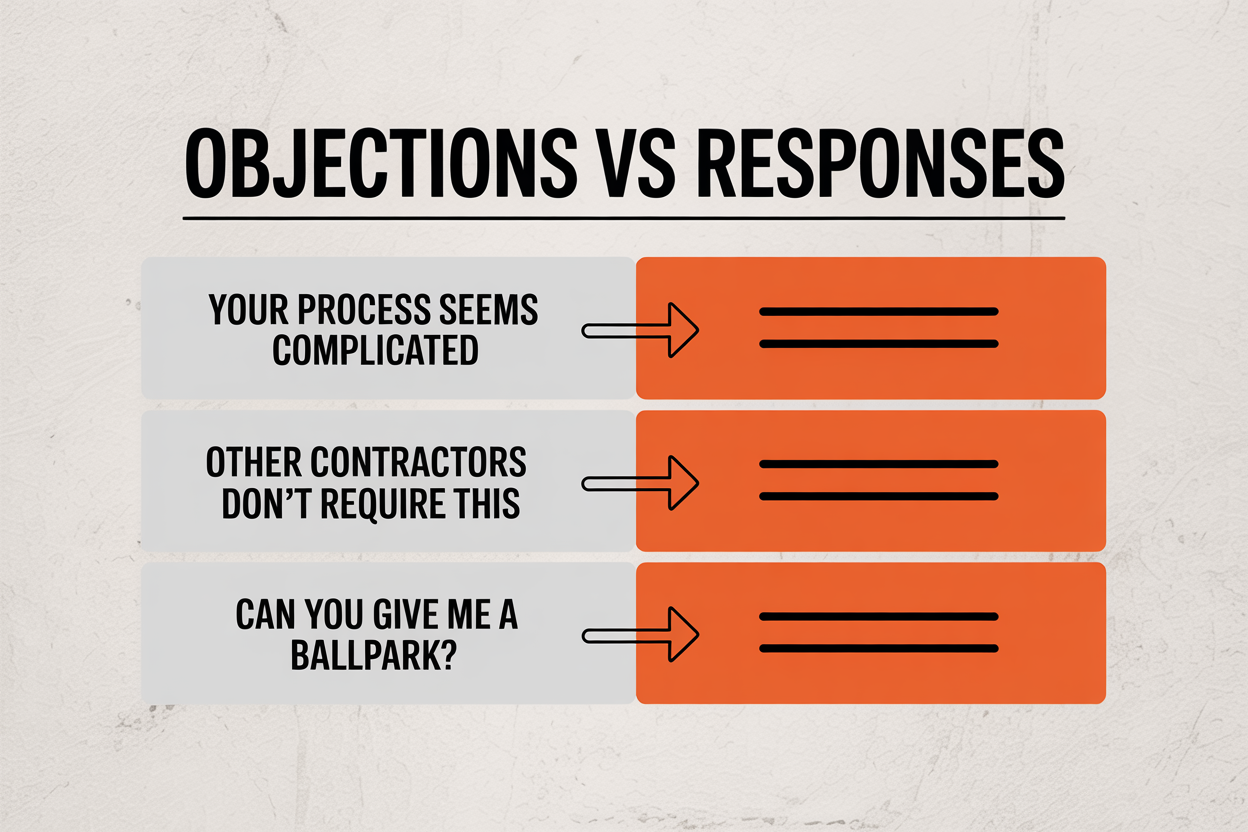
Even with a perfect process, you'll encounter objections. The key is to view these not as roadblocks, but as opportunities to provide more information and build trust.
"Your process seems complicated" Response: "I understand it might seem like a lot of steps, but each one is designed to ensure we deliver exactly what you want, on time and on budget. Would you prefer to invest time upfront to get it right, or deal with costly changes and delays later?"
"Other contractors don't require all this" Response: "You're absolutely right, and that's exactly why 95% of construction projects go over budget or timeline. Our process is what allows us to consistently deliver projects that exceed expectations."
"Can't you just give me a ballpark price?" Response: "I could, but it wouldn't be accurate or fair to you. Every project has unique requirements, and I'd rather give you a precise estimate based on your specific needs than a guess that could be off by thousands of dollars."
The ROI of Professional Sales Systems
Implementing this systematic approach requires an initial investment of time and effort, but the returns are substantial:

One contractor who implemented this system reported closing a $300,000 renovation project directly from their professional info pack, with the client saying they chose them "because they were professional." Another went from doing $30,000 labor jobs to $300,000 full contract projects within months of adopting this approach.
Implementation Strategy: Your Next Steps
Week 1-2: Foundation
- Develop your phone script and practice it until it feels natural
- Create your qualifying questionnaire
- Begin work on your professional info pack
Week 3-4: Systems
- Implement your CRM or tracking system
- Train your team on the new process
- Create templates for follow-up communications
Week 5-6: Launch
- Begin using the system with new prospects
- Refine based on initial feedback
- Track your conversion rates and profit margins
Ongoing: Optimization
- Continuously improve each step based on results
- Gather client feedback and testimonials
- Scale successful elements across your entire operation
General Contractors: Sales Is Your Path to Profitability and Freedom
The construction industry doesn't have to be a race to the bottom on price. By implementing this proven 10-step sales process, you can join the elite 5% of contractors who are booked solid with profitable projects, working with clients who value quality and professionalism over the lowest bid.
This isn't about becoming a pushy salesperson, it's about becoming a trusted advisor who guides clients through one of the most important investments they'll ever make. When you position yourself as a professional consultant rather than just another contractor, you naturally command premium pricing while building stronger, more satisfying client relationships.
The choice is yours: continue competing in the crowded marketplace of price-focused contractors, or differentiate yourself as a premium service provider who delivers exceptional value. The contractors who embrace this systematic approach consistently report not just higher profits, but greater job satisfaction, reduced stress, and the freedom to focus on the projects and clients they truly want to work with.
Your journey from struggling contractor to industry leader starts with your very next prospect. Implement this system, stay consistent with the process, and watch as your business transforms from a source of stress into a vehicle for the professional and financial success you deserve.















